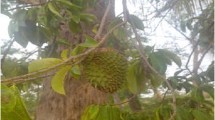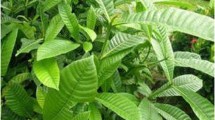Abstract
In present study, the bioactivity of latex-producing plant Pergularia daemia as well as synthesized silver nanoparticles (AgNPs) against the larval instars of Aedes aegypti and Anopheles stephensi mosquito larvae was determined. The range of concentrations of plant latex (1,000, 500, 250, 125, 62.25, and 31.25 ppm) and AgNPs (10, 5, 2.5, 1.25, 0.625, and 0.3125 ppm) were prepared. The LC50 and LC90 values for first, second, third, and fourth instars of synthesized AgNPs-treated first, second, third, and fourth instars of A. aegypti (LC50 = 4.39, 5.12, 5.66, 6.18; LC90 = 9.90, 11.13, 12.40, 12.95 ppm) and A. stephensi (LC50 = 4.41, 5.35, 5.91, 6.47; LC90 = 10.10, 12.04, 13.05, 14.08 ppm) were found many fold lower than crude latex-treated A. aegypti (LC50 = 55.13, 58.81, 75.66, 94.31; LC90 = 113.00, 118.25, 156.95, 175.71 ppm) and A. stephensi (LC50 = 81.47, 92.09, 96.07, 101.31; LC90 = 159.51, 175.97, 180.67, 190.42 ppm). The AgNPs did not exhibit any noticeable effects on Poecillia reticulata after either 24 or 48 h of exposure at their LC50 and LC90 values against fourth-instar larvae of A. aegypti and A. stephensi. The UV-visible analysis shows absorbance for AgNPs at 520 nm. TEM reveals spherical shape of synthesized AgNPs. Particle size analysis revealed that the size of particles ranges from 44 to 255 nm with average size of 123.50 nm. AgNPs were clearly negatively charged (zeta potential −27.4 mV). This is the first report on mosquito larvicidal activity P. daemia-synthesized AgNPs.






Similar content being viewed by others
References
Abbott WS (1925) A method of computing the effectiveness of an insecticide. J Eco Entomol 18:265–266
Ahmad A, Mukherjee P, Senapati S, Mandal D, Khan MI, Kumar R, Sastry M (2003) Extracellular biosynthesis of silver nanoparticles using the fungus Fusarium oxysporum. Colloids Surf B 28:313–318
Anjaneyulu ASN, Raju DVSN, Rao SS (1998) Chemical evaluation of Pergularia daemia. Ind J Chem 37:318–320
Bar H, Bhui DK, Sahoo GP, Sarkar P, De SP, Misra A (2009) Green synthesis of silver nanoparticles using latex of Jatropha curcas. Coll Surf A Physicochem Eng Asp 339:134–139
Deepak D (1995) Phytochemistry of Indian Asclepiadaceae. In: Kiew R (ed) The taxonomy and phytochemistry of the Asclepidaceae in tropical Asia. University Pertanian, Malaysia, pp 33–44
Egorova EM, Revina AA (2000) Synthesis of metallic nanoparticles in reverse micelles in the presence of quercetin. Colloids Surf A Physicochem Eng Asp 168:87–96
Filho OEC, Paumgartten FJR (2000) Toxicity of Euphorbia milii latex and niclosamide to snails and non-target aquatic species. Ecotoxicol Environ Saf 46:342–350
Finney DJ (1971) Probit analysis. Cambridge University Press, Cambridge, pp 76–80
Giridhar G, Deval K, Mittal PK, Vasudevan P (1984) Mosquito control by Calotropis procera latex. Pesticides 18:26–29
Griffitt RJ, Luo J, Gao J, Bonzongo JC, Barber DS (2008) Effects of particle composition and species on toxicity of metallic nanomaterials in aquatic organisms. Environ Toxicol Chem 27:1972–1978
Hebbar SS, Harsha VH, Shripathi V, Hedge GR (2010) Ethnomedicine of Dharward district in Karnataka, India plants use in oral health care. J Ethnopharmacol 94:261–266
Jayaseelan C, Rahuman AA, Rajakumar G, Vishnu Kirthi A, Santhoshkumar T, Marimuthu S, Bagavan A, Kamaraj C, Zahir AA, Elango G (2011a) Synthesis of pediculocidal and larvicidal silver nanoparticles by leaf extract from heartleaf moonseed plant, Tinospora cordifolia Miers. Parasitol Res. doi:10.1007/s00436-010-2242-y
Jayaseelan C, Rahuman AA, Rajakumar G, Santhoshkumar T, Kirthi AV, Marimuthu S, Bagavan A, Kamaraj C, Zahir AA, Elango G, Velayutham K, Rao KV, Karthik L, Raveendran S (2011b) Efficacy of plant-mediated synthesized silver nanoparticles against hematophagous parasites. Parasitol Res. doi:10.1007/s00436-011-2473-6
Kumar V, Yadav SK (2009) Plant-mediated synthesis of silver and gold nanoparticles and their applications. J Chem Technol Biotechnol 84:151–157
Lopes KLB, Thadeo M, Azevedo AA, Soares AA, Meira RMSA (2009) Articulated laticifers of vegetative organs Mandevilla atroviolaceae (Apocynaceae, Apocynoideae). Botany 87:202–209
Marimuthu S, Rahuman AA, Govindasamy R, Thirunavukkarasu S, Arivarasan VK, Chidambaram J, Asokan B, Zahir AA, Elango G, Chinnaperumal K (2011) Evaluation of green synthesized silver nanoparticles against parasites. Parasitol Res 108:1541–154
Mohammed S, Kasera PK, Shula JK (2004) Unexploited plants of potential medicinal value from the Indian Thar desert. Nat Prod Radian 3:61–132
Morsy TA, Rahem MA, Allam KA (2001) Control of Musca domestica third instar larvae by the latex of Calotropis procera (Family: Asclepiadaceae). J Egyp Soc Parasitol 31:107–110
Patil CD, Patil SV, Borase HP, Salunke BK, Salunkhe RB (2011a) Larvicidal activity of silver nanoparticles synthesized using Plumeria rubra plant latex against Aedes aegypti and Anopheles stephensi. Parasitol Res. doi:10.1007/s00436-011-2704-x
Patil CD, Patil SV, Salunke BK, Salunkhe RB (2011b) Prodigiosin produced by Serratia marcescens NMCC46 as a mosquito larvicidal agent against Aedes aegypti and Anopheles stephensi. Parasitol Res 109:1179–1187
Patil CD, Patil SV, Salunke BK, Salunkhe RB (2011c) Bioefficacy of Plumbago zeylanica (Plumbaginaceae) and Cestrum nocturnum (Solanaceae) plant extracts against Aedes aegypti (Diptera: Culicide) and nontarget fish Poecilia reticulata. Parasitol Res 108(5):1253–1263
Rajakumar G, Rahuman AA (2011) Larvicidal activity of synthesized silver nanoparticles using Eclipta prostrata leaf extract against filariasis and malaria vectors. Acta Trop 118(3):196–203
Ramos MV, Bandeira GP, Freitas CDT, Nogueira NAP, Alencar NMN, Sousa PAS, Carvalho AFFU (2006) Latex constituents from Calotropis procera (Ait.) R.Br. display toxicity upon egg hatching and larvae of Aedes aegypti (Linn.). Brazil Mem Inst Oswaldo Cruz 101:503–510
Richardson A, Chan BC, Crouch RD, Janiec A, Chan BC, Crouch RD (2006) Synthesis of silver nanoparticles: an undergraduate laboratory using green approach. Chem Educ 11:331–333
Sakthivadivel M, Danial T (2008) Evaluation of certain insecticidal plants for the control of vector mosquitoes viz. C. quinquefasciatus, An. stephensi and A. aegypti. Appl Entomol Zool 431:57–63
Salunkhe RB, Patil SV, Patil CD, Salunke BK (2011) Larvicidal potential of silver nanoparticles synthesized using fungus Cochliobolus lunatus against Aedes aegypti (Linnaeus, 1762) and Anopheles stephensi Liston (Diptera; Culicidae). Parasitol Res 109(3):823–831
Sathish CJ, Sharma RA, Jain R, Mascalo N, Capasso F, Vijayvergia R et al (1998) Ethnopharmacological evaluation of Pergularia daemia (Forsk.) Chiov. Phytother Res 12:378–380
Shankar SS, Ahmad A, Sastry M (2003) Geranium leaf assisted biosynthesis of silver nanoparticles. Biotechnol Prog 19:1627–1631
Sharma P, Mohan L, Srivastava CN (2009) Amaranthus oleracea and Euphorbia hirta: natural potential larvicidal agents against the urban Indian malaria vector, Anopheles stephensi Liston (Diptera: Culicidae). Parasitol Res 106:171–176
Taubitz W, Cramer JP, Kapaun A, Pfeffer M, Drosten C, Dobler G, Burchard GD, Löscher T (2007) Chikungunya fever in travelers: clinical presentation and course. Clin Infect Dis 45(1):1–4
Thirunavukkarasu S, Rahuman AA, Govindasamy R, Marimuthu S, Asokan B, Chidambaram J, Zahir AA, Elango G, Chinnaperumal K (2010) Synthesis of silver nanoparticles using Nelumbo nucifera leaf extract and its larvicidal activity against malaria and filariasis vectors. Parasitol Res 108(3):693–702
WHO (1980) Expert Committee on Diabetes Mellitus. Second report. Technical report series 646. World Health Organization, Geneva, pp 12–15
WHO (1996) Report of the WHO informal consultation on the evaluation on the testing of insecticides CTD/WHO PES/IC/96.1:69
WHO—World Health Organization 2009. http://www.who.int/mediacentre/factsheets/fs117/en/index.html. Accessed 12 Jan 2012
Author information
Authors and Affiliations
Corresponding author
Rights and permissions
About this article
Cite this article
Patil, C.D., Borase, H.P., Patil, S.V. et al. Larvicidal activity of silver nanoparticles synthesized using Pergularia daemia plant latex against Aedes aegypti and Anopheles stephensi and nontarget fish Poecillia reticulata . Parasitol Res 111, 555–562 (2012). https://doi.org/10.1007/s00436-012-2867-0
Received:
Accepted:
Published:
Issue Date:
DOI: https://doi.org/10.1007/s00436-012-2867-0




